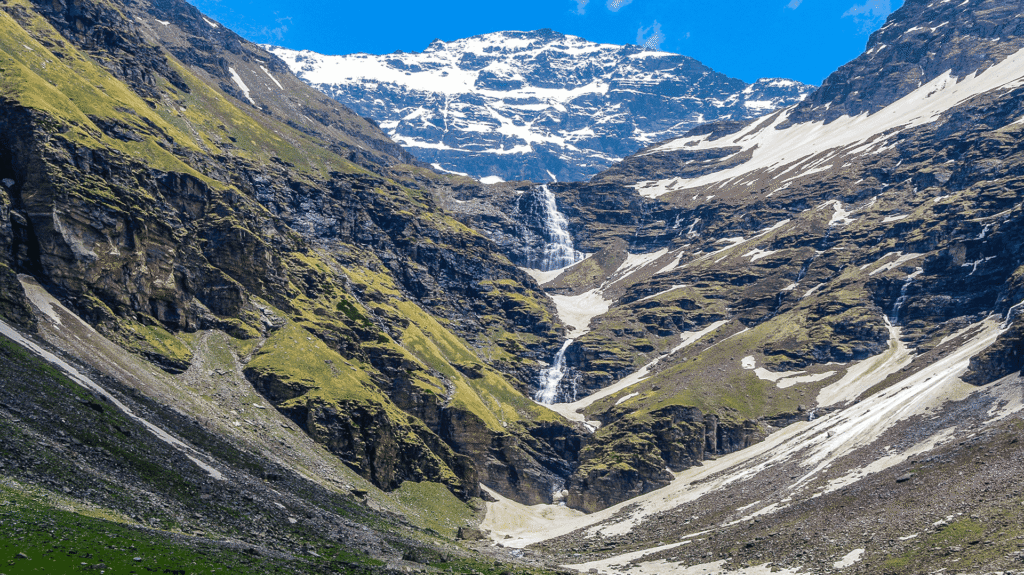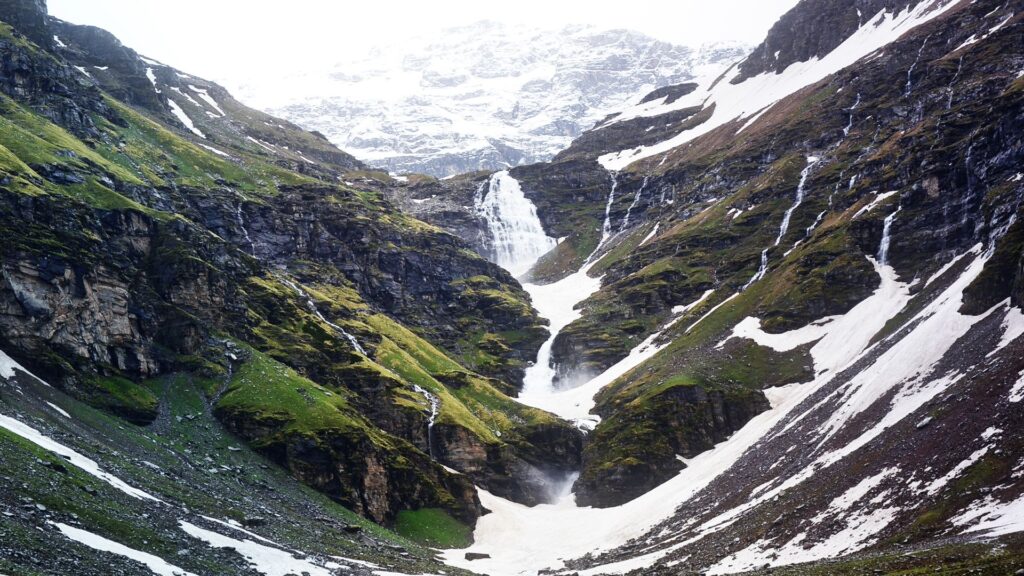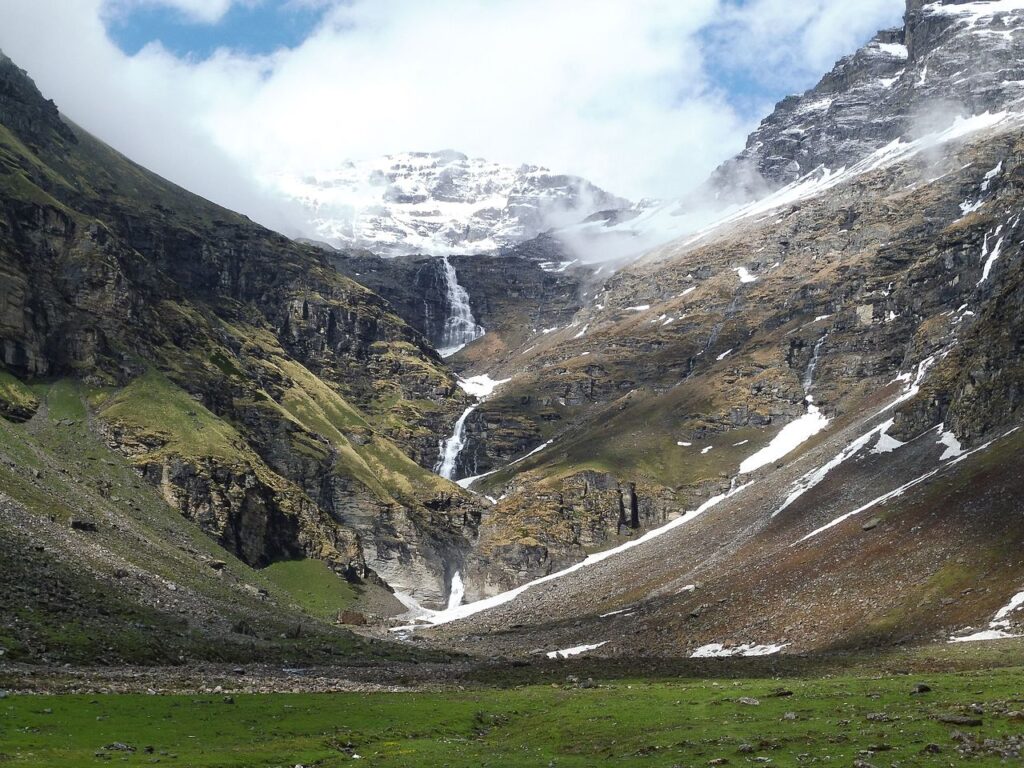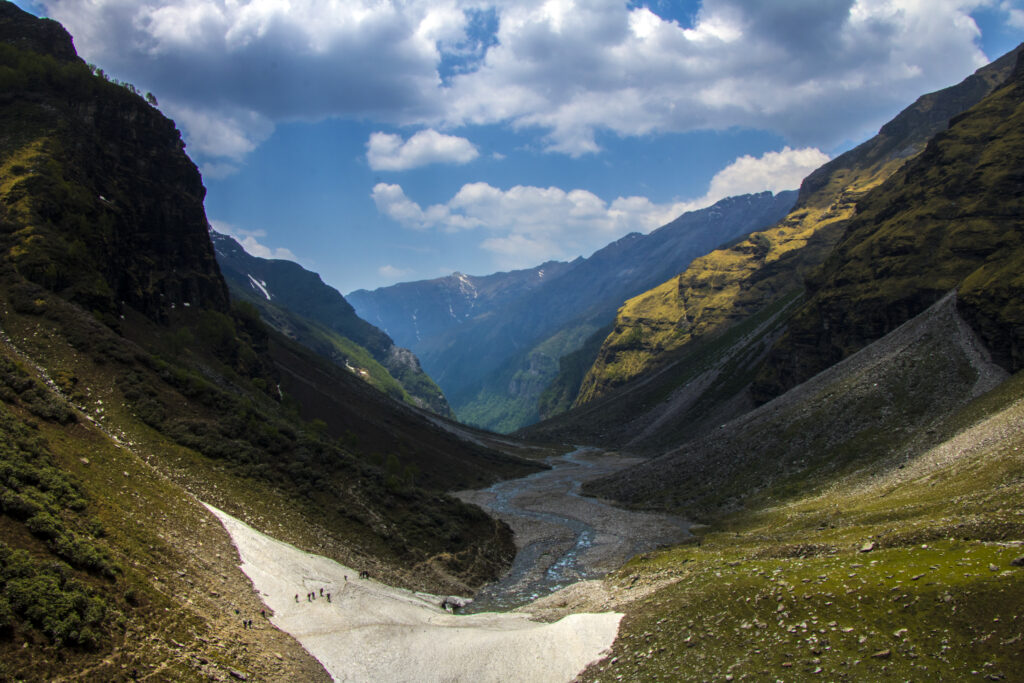Do you envision a thrilling high-altitude trek across state lines and presenting a variety of landscapes? Seek no further than the Rupin Pass Trek, an awe-inspiring crossover trek situated in the middle of the Indian Himalayas. This website is your ultimate source of information on planning and tackling this stunning trail, from the green valleys of Uttarakhand to the beautiful Kinnaur district of Himachal Pradesh.
Why Rupin Pass? More Than Just a Trek!
The Rupin Pass trek is famous for the radical changes in scenery, and so it’s one of India’s most scenically rewarding treks. Visualize trekking through:

Dense Pine and Rhododendron Forests: The lower reaches are a colorful canopy of green, particularly in spring.
Elegant Mountain Hamlets: Witness the distinctive culture and hospitality of villages such as Jhaka, the “hanging village,” balanced on the edge of a cliff.
Thundering Waterfalls: View the famous multi-level Rupin Waterfall, a marvel of natural force in action.
Rolling Meadows (Thaches): Find peaceful alpine meadows such as Dhanderas Thatch and Suruwas Thach, providing peaceful beauty.
Thrilling Snow Bridges and Fields: During the pre-monsoon period, expect a thrilling trek over natural snow bridges and large snowfields for an added dose of real adventure.
Panoramic Himalayan Views: The biggest reward is the unobstructed 360-degree view of the Dhauladhar and Kinnaur Kailash ranges from the top of Rupin Pass.
As opposed to some of the more commercial treks, Rupin Pass is a comparitively peaceful experience, and you are able to be fully immersed in the backcountry and the deep quiet of the mountains.
Rupin Pass Trek: In Brief
- Difficulty Level: Moderate to Difficult. Novices with good physical conditioning can go for it, but previous high-altitude trekking experience is an absolute plus.
- Highest Altitude: About 15,250 feet (4,650 meters) at Rupin Pass.
- Total Distance of the Trek: Approximately 40-52 kilometers, depending upon the route selected and variations in itineraries.
- Duration: Normally 7-9 days (including going to and returning from base camp).
- Starting Point: Dhaula (Uttarakhand) or Jiskun/Bawta (Himachal Pradesh). The most common trails begin at Dhaula.
- Ending Point: Sangla (Himachal Pradesh).
- States Covered: Uttarakhand and Himachal Pradesh.
Best Time to Overcome Rupin Pass
Rupin Pass trek can be best done in two different windows, each having a different charm:
May to June (Spring/Early Summer):
- Highlights: Look out for large patches of snow, particularly around the pass. It is the best time for a traditional snow trek experience with snow bridges being one of the highlights. Rhododendrons are in bloom, painting the lower trails with diverse colours.
- Weather: Moderate daytime temperatures (15°C to 20°C) at lower elevations, ranging from 0°C to 7°C at night at higher elevations. A few rain showers or hailstorms can be expected.
September to Mid-October (Post-Monsoon/Autumn):
- Highlights: Post-monsoon lush green vistas, clearer blue skies, and unrestricted vistas of the high peaks. The paths are relatively drier. Golden hues of autumn color the valleys.
- Weather: Fine daytime temperatures (10°C to 15°C) but nights are progressively cold (down to -5°C in higher altitudes). Remoter possibility of rain or heavy snowfall.
Avoid: July and August because of heavy monsoon rain, which is slippery and landslide-prone to trails. Winter months (Nov to Apr) are not recommended because of very heavy snowfall that makes the pass unapproachable and the conditions harsh.





Rupin Pass Trek Itinerary (Standard 7-Day Course from Dhaula)
Although itineraries might differ slightly among operators, the following is a typical 7-day outline:
First Day: Dehradun to Dhaula (Drive)
- Altitude: ~1,580 m (5,180 ft)
- Journey: Scenic 8-9 hours, 200 km drive from Dehradun through quaint villages and towns and along the Rupin River.
- Accommodation: Dhaula camps/guesthouse. Team briefing and introduction.
Second Day: Sewa to Aaligad/Jhaka via Dhaula
- Altitude: ~2,000 m (6,560 ft) to ~2,400 m (7,870 ft) (alt of campsite)
- Trek Distance: 10-14 km
- Duration: 6-7 hours
- Highlights: Day one of trekking! Cross the Rupin River, walk through quaint villages, and see the ancient Shiva temple at Sewa. The path is usually characterized by slow ascents and descents through the forests. Some routes may go as far as to the “hanging village” of Jhaka on this day.
Third Day: Aaligad/Jhaka to Dandreyash Thatch
- Altitude: ~3,570 m (11,700 ft)
- Trek Distance: 8-11 km
- Duration: 7-8 hours
- Highlights: A tougher day with considerable altitude gain. The scenery starts to change as you hike through thick forests, occasionally facing small streams and waterfalls. Arrive at the picturesque meadows of Dandreyash Thatch.
Fourth Day: Dandreyash Thatch to Upper Waterfall Camp (Lower Waterfall Camp)
- Altitude: ~3,950 m (13,000 ft) to 4,050 m (13,300 ft)
- Trek Distance: 4-5 km
- Duration: 4-5 hours
- Highlights: This is usually the most scenic day. You will reach the beautiful Rupin Waterfall, a cascading multi-tiered beauty. Based on the snow situation and the chosen itinerary, you may camp at Lower Waterfall or drive up to Upper Waterfall. This is an important acclimatization day.
Fifth Day: Upper Waterfall Camp to Rupin Pass to Ronti Gad (Summit Day!)
- Altitude: 4,650 m (15,250 ft) (Rupin Pass) and descend to ~4,100 m (13,420 ft) (Ronti Gad)
- Trek Distance: 10-12 km
- Time: 10-12 hours (longest and most difficult day)
- Highlights: Summit day! Get up very early (approx. 4-5 AM) in order to capitalize on good morning weather. The best part of the climb to Rupin Pass is usually when one faces steep inclines on scree or snow, also referred to as the “Rupin Gully.” Microspikes and trekking poles are a must. The panoramic view at the top is unmatched. The downhill trek to Ronti Gad on the Himachal side is also very exciting, with new landscapes opening up and ultimately bringing one back to a greener environment.
Sixth Day: Ronti Gad to Sangla (Drive to Shimla/Base)
- Altitude: Down to ~2,600 m (8,530 ft) (Sangla)
- Trek Distance: 8-12 km
- Time: 5-7 hours trek, followed by a 8-10 hours drive to Shimla.
- Highlights: A final descent into scenic pine landscapes, apple orchards, and hamlets, the end of the trekking phase of the trek. From Sangla, you will be driven back to Shimla, where you can relax or board your onward travel.
Seventh Day: Buffer Day / Leaving Shimla
The day is usually kept as a buffer against unexpected situations or just for relaxation before your return home.

Fitness and Preparation: Are You Ready for Rupin Pass?
Rupin Pass trek falls under the level of moderate to challenging, requiring a high level of physical fitness and mental strength. Here’s your preparation:
- Cardiovascular Training: Begin at least 4-6 weeks prior to your trek. Perform activities such as jogging, cycling, swimming, and brisk walking for 45-60 minutes, 4-5 times a week. Try to jog comfortably 5 km.
- Strength Training: Emphasize leg and core strength. Squats, lunges, planks, and calf raises are extremely useful.
- Endurance: Train walking with a weighted backpack (5-7 kg) to mimic trail conditions.
- Flexibility: Add stretching to your regime to avoid muscle rigidity.
- Altitude Acclimatization: The itinerary is designed to allow for gradual acclimatization, but listen to your body. Stay hydrated, walk at a steady pace, and report any symptoms of AMS immediately to your trek leader.
- Battling Altitude Sickness (AMS)
Acute Mountain Sickness (AMS) is a real concern on high-altitude treks like Rupin Pass. Be aware of the symptoms and take precautions:
- Symptoms: Headache, nausea, dizziness, fatigue, loss of appetite, shortness of breath, disturbed sleep.
- Prevention:
- Gradual Ascent: The itinerary helps with this.
- Hydration: Stay well hydrated during the day (3-4 liters of water).
- Slow Pace: Do not speed along; keep a regular rhythm.
- Acclimatization Walks: From campsites, short excursions to higher altitudes and then back down to camp.
- Avoid Alcohol and Smoking: These aggravate AMS symptoms.
- Diamox (Acetazolamide): Talk to your doctor regarding taking Diamox as a prophylactic.
- Immediate Descent: In case of worsening symptoms, the best cure is immediate descent to a lower altitude. Your trek leader will be trained for that.
Must-Have Packing List for Rupin Pass Trek
Packing intelligently is important for a safe and comfortable trek. Here’s an exhaustive list:
Clothing:
- Layered Clothing: A must for changing temperatures.
- Thermal innerwear (1-2 sets)
- Quick-dry trekking t-shirts (3-4) – full-sleeved ones advisable for sun protection.
- Fleece jacket (1-2)
- Down jacket (1) – for very cold weather at higher camps and pass crossing.
- Waterproof and windproof outer shell jacket (1)
- Trekking pants (2-3 pairs) – don’t use jeans.
- Waterproof trekking pants (1)
- Socks:
- Woolen socks (3-4 pairs)
- Cotton/synthetic socks (2-3 pairs) – for lower altitudes.
Footwear:
- High-ankle Trekking Shoes: Waterproof, rugged, with good grip and ankle protection (most critical!).
- Camp Sandals/Floaters: For relaxation at camps.
- Gaiters: To keep snow out of your shoes.
- Microspikes: Essential for walking on snowy patches and snowfields (your trek operator typically supplies these if necessary).
Head & Hand Protection:
- Woolen Cap/Balaclava: For cold protection.
- Sun Cap/Hat: For protection from the sun.
- Woolen Gloves (1 pair):
- Waterproof Gloves (1 pair):
Personal Gear:
- Backpack (55-65 liters): With rain cover.
- Daypack (15-20 liters): For the summit day.
- Trekking Poles (1 pair): Strongly recommended for stability and minimizing knee strain.
- Headlamp/Torch: With spare batteries.
- Water Bottles (2 liters capacity) or Hydration Bladder: At least 2 liters of water to carry. A thermos is suitable for hot water.
- Sunglasses (UV protected): Necessary to avoid snow blindness.
- Sunscreen (SPF 50+):
- Lip Balm (with SPF):
- Personal First-Aid Kit: Band-aids, antiseptic, painkillers, muscle relaxants, blister plasters, rehydration salts, any personal medicines.
- Toiletries: Biodegradable soap, toothpaste, toothbrush, hand sanitizer, wet wipes, toilet paper.
- Towel (quick-dry):
- Personal Snacks: Energy bars, dry fruits, nuts, chocolates.
- Camera: With additional batteries/power bank.
- Power Bank:
- Documents: Proof of identity, medical certificate (if needed by the operator), trek permits (generally organized by the operator).
- Reusable Bags: For your own trash collection.
- Permits and Regulations
- In general, your trekking operator will organize all the permits and forest entry charges for the Rupin Pass trek. Nevertheless, it’s always best to double-check this with them prior to making a booking. Carry a valid proof of identity (Aadhar Card, Voter ID, Passport) with you.
Cost of Rupin Pass Trek
The Rupin Pass trek cost depends on the trekking company, duration, inclusions, and group size. A 7-day Rupin Pass trek costs anything between INR 15,000 to INR 25,000 per person on average.
Inclusions normally include:
- Accommodation (tents, occasional guesthouses or homestays)
- All meals on the trek (healthy vegetarian food)
- Trained and certified trek guides/leaders
- Support staff (cooks, porters/mules for the transport of equipment)
- Camping gear (tents, sleeping bags, mattresses)
- First-aid and medical kit (including oxygen cylinders)
- Trekking permits and forest fees
- Exclusions usually include:
Transportation to and from base camp (e.g., Dehradun/Shimla to Dhaula/Sangla)
- Personal expenses (snacks, drinks, phone recharging)
- Offloading charges for personal bags (if you don’t wish to carry your own backpack)
- Travel insurance
- Any expenses owing to changes in itinerary (e.g., poor weather, landslides)
- Guides, Porters, and Safety
- Experienced Guides: Treaking Rupin Pass with a seasoned and certified trekking company is strongly advised. Their trek leaders are instructed in high-altitude trekking, first aid, and dealing with difficult terrain.
- Porters/Mules: Porters and mules are usually available through your trekking company to transport group equipment and often individual baggage (if you have paid for offloading). This makes the trek a lot lighter and more enjoyable.
Safety First:
- Always stick to the instructions given by your trek leader.
- Stay on the waymarked trail.
- Report your guide at once if you develop any illness.
- Avoid alcohol and other intoxicants during the trek.
- Have sufficient cash for emergencies or small transactions in villages.
- Carry a fully charged mobile phone (though network is spotty).
- Take travel insurance that includes coverage for high-altitude trekking.
Food on the Trail
Trekking companies usually serve plain, wholesome, and hot food during the trek. A healthy amount of carbohydrates and proteins will keep you going. Commonly served meals are:
- Breakfast: Poha, Upma, Bread Omelette, Parathas.
- Lunch: Lunch packs (chapati, sabzi, occasionally rice) on the trail, or hot lunch at camps.
- Dinner: Dal, Rice, Mixed Vegetables, Chapati.
- Snacks: Evening tea with biscuits/Maggi.
- Hydration: Hot drinks such as tea and soup are available at camps. Bring water purification tablets or a Lifestraw to fill water from natural sources.
Connecting with Nature and Culture
In addition to the terrain challenge, Rupin Pass provides an intense connection with the Himalayas. The opportunity to engage with the village communities at Jhaka, observe their wooden houses, and experience their uncomplicated life provides a strong cultural dimension to your journey. Make sure to practice responsible tourism:
- Leave No Trace: Take back all your trash, including plastic wraps.
- Respect Local Culture: Dress appropriately and respect local traditions.
- Support Local Economy: Purchase local fruits or handicrafts whenever you can.
Your Rupin Pass Adventure Awaits!
The Rupin Pass trek is not merely a stroll in the hills; it’s an odyssey that challenges your boundaries and repays you with scenes of unimaginable beauty and an overwhelming feeling of achievement. The constantly changing landscapes, the excitement of traversing a high-altitude pass, and the cultural interaction make it an experience to remember. So, strap on your hiking boots, put your body and mind in gear, and get set to go on one of Himachal Pradesh’s most legendary and rewarding hikes!
